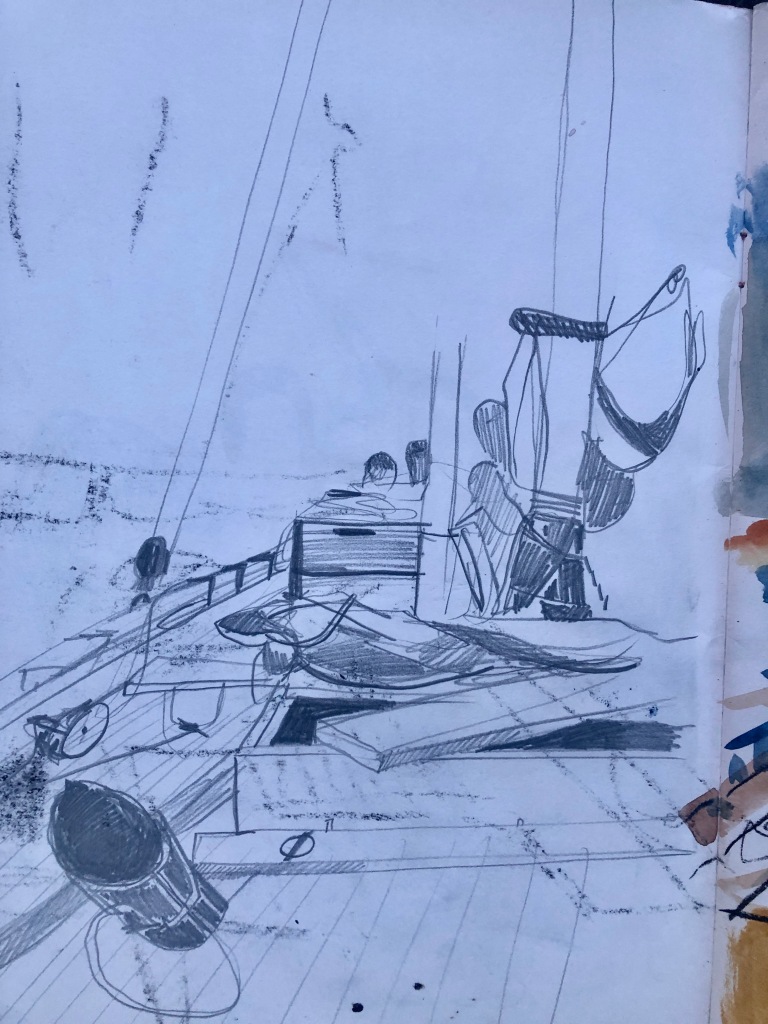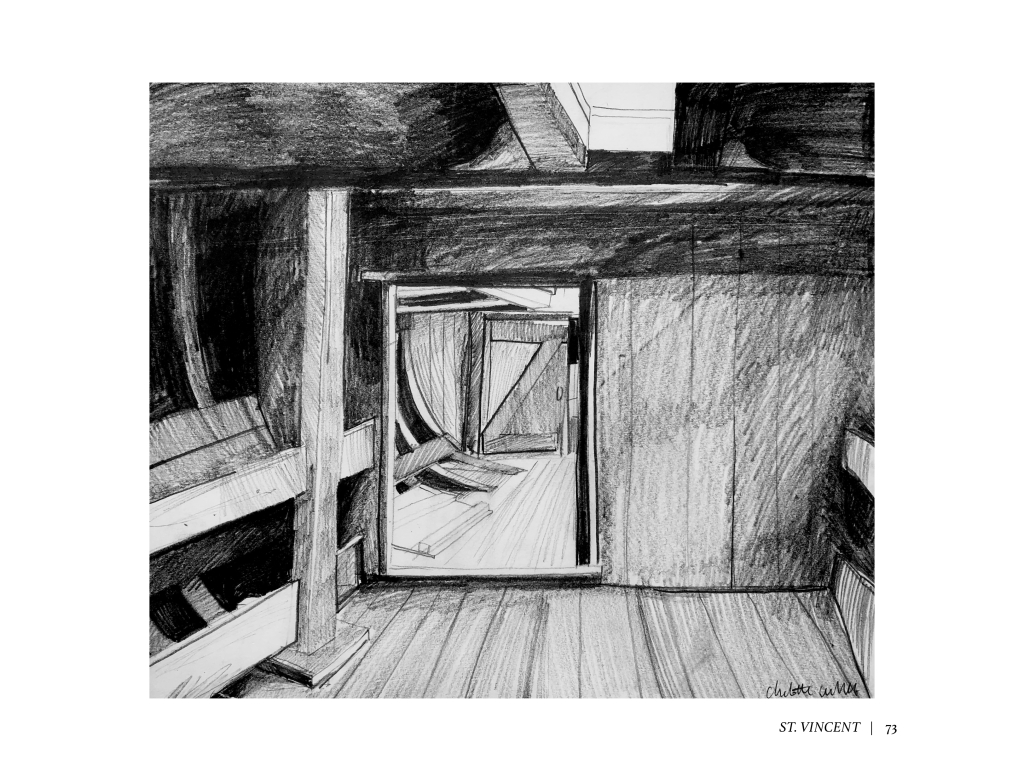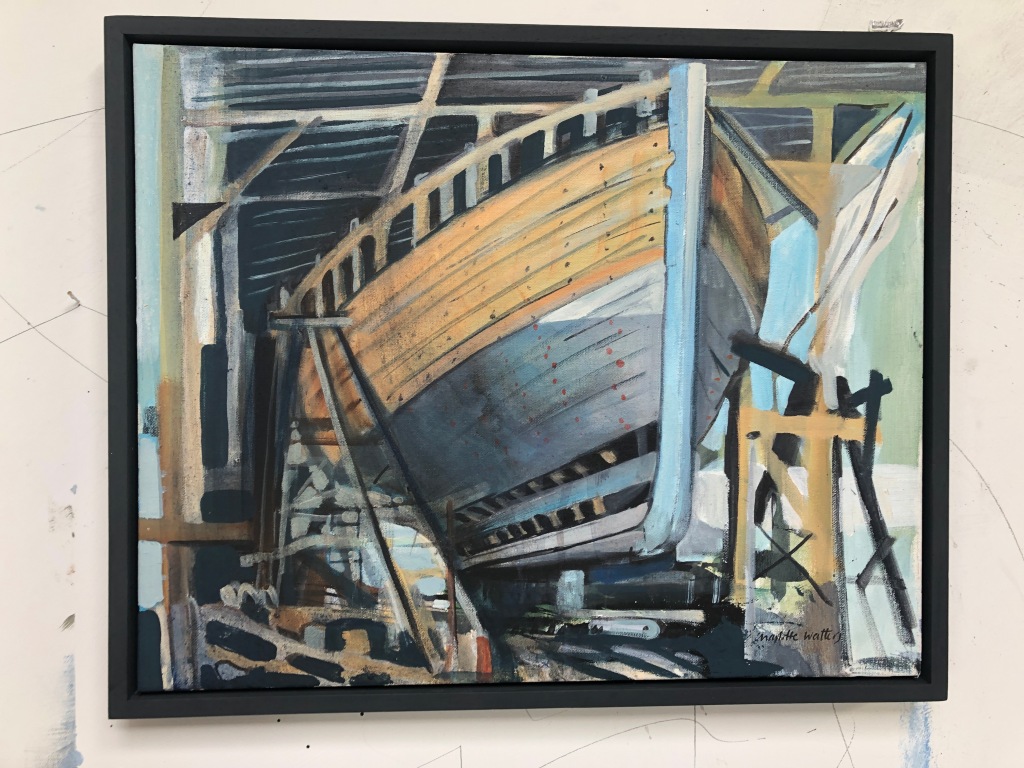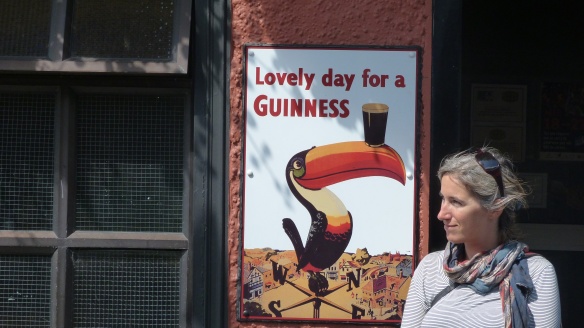
Hello, I introduced St. Vincent in my recent post, she is a 1910 Zulu Herring Drifter which was restored recently at the Johnson and Loftus Boatyard near Ullapool. These restorations have been funded by the Summer Isles Enterprises based on Tanera Mor in the Summer Isles, designed to preserve and continue their future, to function and sail as working museum pieces.
During the restorations I had the opportunity to go regularly and draw and paint the process. I brought these drawings together into a book this year, titled “Drawn Lines”. As well as drawings of the St. Vincent, this book also features some drawings of the Clan Gordon , another Scottish Fishing boat from this era, a Loch Fine Skiff which was also undergoing an extensive rebuild and was also launched this year.
This summer, after the 2 and a half year restorations, launches, celebrations and test sails, these two boats have had a chance take to the water and put some miles under their keels again. I was able to join the boats to sail with St. Vincent round the Highlands of Scotland from their home on the West Coast .
The incentive to take these boats East this summer was to sail them to the Portsoy Boat Festival, which is held annually on the East Coast of Scotland, close to where St. Vincent was originally built.
This meant a sail north, up through the Pentland Firth and down to the village of Port Soy on the Moray coast. Of course once we were to take them East, the route back to the West Coast was to be considered. A plan was set to sail a circular route, circumnavigating the Highlands, west bound through the Caledonian Canal and back up the West Coast to Ullapool.
I crewed aboard St. Vincent during the trip and it is from this perspective that I am writing . Alastair Grant and his crew on board the Clan Gordon sailed with us in company in large part on the trip, however different commitments and time frames meant sections of the journey were done separately too.
I am writing here about the first leg of this trip, With hope I will get round to writing the next section , and if this comes to fruition , I will post it here …
On board the St. Vincent . Dipping Lug Rig, 50 foot Zulu Herring Drifter.
Tanera to Port Soy
Crew – Dan Johnson, Tim Loftus, Charlotte Watters , Diane Ross, Carlos Fernandez, Kade Stoddart, Connie Anderson, Robbie Punt

20th June – 23rd June
We joined St. Vincent on her mooring in the bay at Tanera Mor on the 20th June. With the crew assembled onboard and with no wind at all to set sail, we were given the generous assistance of a tow out by one of the RIBs from Tanera, out to the channel by Isle Ristol.
Alistair Grant and his crew on board the Clan Gordon had left crack of dawn that morning, early from Isle Ewe, we could see their position on the phone find my friend app, GPS, but they were way off, 10 plus miles ahead of us into the Minch.
A mile or so out from the bay at Tanera there was the suggestion of a breeze on the water and so the RIB cast us off and we set sail, able to make our way out past the Summer Isles and Rhu Coigach. As the breeze developed we had good wind for the first few hours of our journey. The land grew blue and dark behind the rain clouds, filtering into shades of grey and white as the folds of land were alternatively met with the rain.
As the wind then died to a whisper and in the easy heat of the warm day we only slowly made way north with Store Point off the bow for many hours and the familiar hills of Assynt and Coigach remaining stedfast out to starboard.
The calm sea and little swell revealed marine life we may well have missed sight of in other conditions, or maybe due to being a transitional time for feeding or migrating, we saw a lot of breaches in the water – many sightings of Dolphins, Fin Whales, Minkie Whales and even 2 Orca, their great fins tall and strong slicing south through the water.
Our progress was slow through the night. The long summer light made it possible to see or at least make out the coastline all night long even though we were several miles off shore. Before the darkness thickened we could just make out Clan Gordon at anchor below the Cliffs of Handa as they had stopped for rest and to wait for the wind to later strengthen.
Our progress was slow and then negative as the tide turned and by 2am we were being slowly swept backwards unable to make way with so little wind, before the tide turned again in our favour and the breeze enough to use.
21st June – Mid Summers’ Day
By 9am we were rounding Cape Wrath. The wind had strengthened from the west and we were striding along the top. We had a great sail passing the North Coast with a strong wind we were experiencing St. Vincent in conditions we hadn’t yet had with her since she was relaunched in May. She is so heavy and sure in the water, very comfortable and solid.
With no reef in the main or mizzen we were storming along. We had caught sight of Alistair in the Clan Gordon and since mid morning we sailed all the way in sight of them adding an edge of competition as the distance between the 2 boats fluctuated through the day .
With a strong wind from behind we strategised a Gybe and made way for Scrabster Bay where were planned to stop for a couple of hours in order to wait for the tide around the next point and the significant currents of the Pentland Firth.
We had been studying the charts and reading passage notes from the 1930s pilot books we had with us, with descriptive yet matter of fact and alarming langue. The tide that rips through this narrow passage between mainland Scotland and Orkney is studded with many additional rocks and is regarded as a dangerous area for shipping with one of the most powerful tidal currents in the world. This can create tidal swell waves several metres in height in places and with whirl pools and back eddies. Although several of us onboard had sailed through the Pentland Firth before, none had done it on an engineless boat. The experience of being at the effects of the tide and wind, or lack of it with the lug rig and no option of engine assistance was enlivening. In the main flow of the tide the assistance of the engine may not make much difference , but when the wind dies, or backs off just that little bit too much, it can help to push you into a more favourable place, to catch the currents as they move. we didn’t have that option, although we did have oars…
We set off again from Scrabster Bay after dinner and reason for contemplation, into a red evening light and a jabbley sea on a dyeing breeze.
We were able to just make way East, but the course and the momentum was very staggered. We thought to stop several times in some of the exposed bays , as the light was fading and as tide had not so long left to run in our favour. Clan Gordon managed to anchor in Gills Bay, but 10 minutes after them we were too late for that option as we couldn’t cross the strong cross current that blocked the entrance to the bay. We were only able to go with it and we were on course to pass north of Hell Rocks and on passed John O’ Groats, due to be spat out into the North Sea. We were hairing along with the dark land passing us by and the first stars piercing through .
Clear of the Firth now, we set course on the next chapter of the passage with a good wind and tide, south east to Portsoy. A big sea was running, but the stedfast and sure St. Vincent took happily to it. The motion and rise of the heavy boat rarely breaking water on the deck despite the swell. We ploughed on through the dark night with the red navigation lights of the industrial Wick and then the 30 mile wide field of wind turbines off to Starboard. We made good time and covered the distance.
We arrived in the tight harbour of Whitehills on a bright and sunny midday on the 22nd of June. We planned to leave the boat here for some days , before the festival was to take place in Portsoy , a few miles to the west, as it was a better harbour to leave the boat in for some time as we were were planning to head home and then return to her later in the week.
Closing in on the East Coast harbour takes confidence as the harbour wall looks like an impenetrable concrete wall. As we approached though, we could make out the lead in, and the chart now seemed more believable. We took the sails down and and with a few sweeps with the oars were in close enough to throw our warps up to the generous and welcoming harbour master ,enthused so see such a boat coming in under sail and oar as would have been an everyday sight decades ago, but now was a rare sight. The 90 degree turns with our hugely protruding bow sprit and boomkin was a tight manoeuvre, but with neat work with the warps between pier and deck, we were in, tied up and basking in the beautify hot summers’ day and the pleasure of the successful completion of our first leg of the trip.
We left the boat here until our return , to sail her west to the Festival at Portsoy.
I hope to write up and post the next part of the trip…

























































































































































